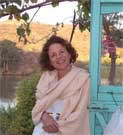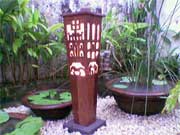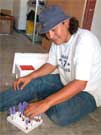By ELIZABETH PISANI, FOR ASIA TIMES
1200 words
2 August 1996
<
Asia Times
English
(c) 1996 Chamber World Network International Ltd
Tep Vattho is afraid of ghosts. From that fear has sprung perhaps the most beautiful hotel in Siem Reap, Cambodia. Tep Vattho, the daughter of a cultured official who cultivated orchids when not practising as a judge, fled the country at the age of 12. Two weeks later, Cambodia imploded with the bloody zeal of its Khmer Rouge rulers.
Educated in France, Tep Vattho, at the instigation of her brother, studied medicine for two years. "She didn't like the blood and was scared of ghosts," said her elder sister Tep Rath Otine. "So she switched to architecture."
While studying in Paris, she met and married French colleague Olivier Piot. Together, they dreamed of returning to Tep Vattho's homeland and building a hotel in the Khmer style, using local craftsmen and traditional mat er ials. Piot pored over records at the Museum of Asian Art in Paris, and settled on a monk's village as the model for the project. The result is a delightful collection of wooden houses, built around courtyards that spread from a central dining area. "Cambodia has lost a large part of its traditions of wooden architecture, which in the Angkor period must have been stunning," mourned the young Frenchman.
Hidden in a quiet corner of Siem Reap just 14 km from the magnificent temples of Cambodia's 10th to 12th century glory years, Angkor Village's elegance stands out in a sea of schlock. Nearby are a number of hotels more typical of current Cambodian style - appalling velveteen artwork lit by tacky Chinese chandeliers, boxed in by traditional roofs recreated in clumsy concrete. None of this at Angkor Village. Here, fresh lotus flowers curve gracefully out of terra cotta jars on open verandas and everything down to the ashtrays comes from local craftsmen. Although regular guests adore the elegant simplicity - "I come here whenever I have an excuse, and sometimes when I don't," said Canada's ambassador to Cambodia Gordon Longmuir - others have been known to complain.
Tep Rath Otine, who now manages the hotel, explained: "They say it's not luxurious enough, that we don't have mini-bars in the rooms, or TV. I say we want this to be calm, thoughtful, like a pagoda. Do they have TVs in pagodas?" Vocal morning cockerels notwithstanding, the place is certainly calm. Young Khmer women drift around in their long skirts, sweeping dry season dust from the wide, wooden floors. In the evening, the loudest sound is the droning of crickets. This other-worldly atmosphere comes as a balm after the honking horns, crashing guns and shrill political debates of the capital Phnom Penh.
"We wanted to help the country recover its cultural identity, which has been so much maimed by wars, by genocide and now by the market economy," said Piot. This goal is especially close to the heart of Tep Rath Otine, who stayed in Cambodia throughout the traumatic years of Khmer Rouge rule and the subsequent civil war. She saw three of her brothers die under the Khmer Rouge, then, working as a nurse, saved the life of the wife of her brother's executioner when she was hemorrhaging in pregnancy.
"All Cambodia has been through this, we are losing our traditions and I don't like that," she said, wiping a tear from her eye. Tep Rath Otine has employed girls from the villages around Siem Reap. "Many of them have lost their parents - have lost their mothers. I'm training them to move slowly, to smile, to be gentle. To be good Khmer women."
Worn down by the years of toiling in rice fields, Tep Rath Otine, who tried to hide her well-educated origins from the mad Maoists then running the country, said she occasionally has her doubts. "I want to help preserve Khmer culture, but I do sometimes think about the other side of our history - the wars and the violence." Most of the guests at the hotel will troop off to visit Angkor Wat. Many will go on to contemplate the bas-reliefs around the Bayon temple, which depict the vicious wars that raged between the Khmer and Cham kingdoms about a millennium ago. Here warriors hold the severed heads of their enemies aloft, waving their swords triumphantly and appearing to bay for more blood. The violence is not the only side of Khmer culture that troubles Tep Rath Otine. Now she finds she must contend with a rising tide of prostitution, too.
Appearing in large numbers to serve United Nations peacekeeping troops in the early 1990s, prostitutes have become a fixture of life for Cambodian civil servants of all ranks, and a draw for tourists from other Asian nations. Tep Rath Otine tackles the problem in two ways. "I forbid prostitutes from coming here and I give village girls a decent living."
Angkor Village has become something of a beacon in a world of cut-throat tourist development. Siem Reap was Khmer Rouge territory until just a few years ago. With the security situation still uncertain, most investors want to build cheap, fill high-priced rooms with busloads of Japanese tourists, take the money and run as soon as possible.
Ironically, the moderately priced Angkor Village is one of the great business successes of the area. With no advertising, the hotel's 17 rooms, which go for between US$46 and US$55 a night, began to fill up right from the start. "It went from mouth to ear, and it went fast," Tep Rath Otine said. By the Christmas high season last year, less than a year after opening, 86 percent of rooms were filled. At weekends, when Phnom Penh residents come to decompress, there is rarely a bed empty.
"The hotel is an example to the local authorities - it points the way for future investors in respecting the environment and Khmer culture," Piot said. The authorities include his wife, who is Angkor Village's co-owner and now runs the Bureau of Urban Planning in Siem Reap.
They are proud of the contribution the hotel has made to the local economy. "Everything was made by hand," said Tep Rath Otine. This was no mean feat - the Khmer Rouge had little patience for decorative arts and killed anyone they suspected of partaking in such a bourgeois occupation, so the hunt for craftsmen was not an easy one.
"We went around to all the monasteries in the area and asked the old monks if they could remember who helped build the pagodas," Tep Rath Otine said. They wound up with 20 or 30 carpenters who took more than two years to put together the Angkor Village complex, all built on stilts and much of it open to the elements.
The cool, breezy result is a haven in a country where violence is still something of a norm. Although this architectural dream and the ghosts that bore it have deprived Cambodia of a doctor, they have done much for the nation's cultural health.
Elizabeth Pisani is a contributing writer for Asia Times based in Brussels.
Copyright 1996 Asia Times.
(c) 1996 Chamber World Network International Ltd.




